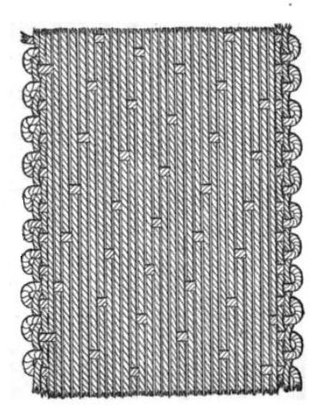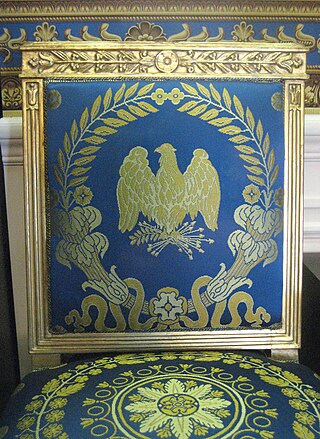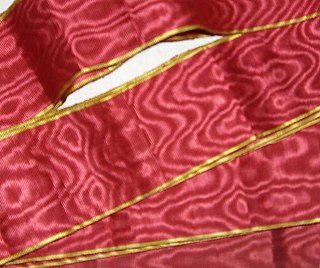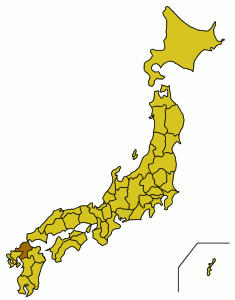
Calico is a heavy plain-woven textile made from unbleached, and often not fully processed, cotton. It may also contain unseparated husk parts. The fabric is far coarser than muslin, but less coarse and thick than canvas or denim. However, it is still very cheap owing to its unfinished and undyed appearance.

Weaving is a method of textile production in which two distinct sets of yarns or threads are interlaced at right angles to form a fabric or cloth. Other methods are knitting, crocheting, felting, and braiding or plaiting. The longitudinal threads are called the warp and the lateral threads are the weft, woof, or filling. The method in which these threads are interwoven affects the characteristics of the cloth. Cloth is usually woven on a loom, a device that holds the warp threads in place while filling threads are woven through them. A fabric band that meets this definition of cloth can also be made using other methods, including tablet weaving, back strap loom, or other techniques that can be done without looms.

Textile arts are arts and crafts that use plant, animal, or synthetic fibers to construct practical or decorative objects.

A satin weave is a type of fabric weave that produces a characteristically glossy, smooth or lustrous material, typically with a glossy top surface and a dull back; it is not durable, as it tends to snag. It is one of three fundamental types of textile weaves alongside plain weave and twill weave.
Ikat is a dyeing technique from Indonesia used to pattern textiles that employs resist dyeing on the yarns prior to dyeing and weaving the fabric. The term is also used to refer to related and unrelated traditions in other cultures. In Southeast Asia, where it is the most widespread, ikat weaving traditions can be divided into two general clades. The first is found among Daic-speaking peoples. The second, larger group is found among the Austronesian peoples and spread via the Austronesian expansion. Similar dyeing and weaving techniques that developed independently are also present in other regions of the world, including India, Central Asia, Japan, Africa, and the Americas

Damask is a reversible patterned fabric of silk, wool, linen, cotton, or synthetic fibers, with a pattern formed by weaving. Damasks are woven with one warp yarn and one weft yarn, usually with the pattern in warp-faced satin weave and the ground in weft-faced or sateen weave. Twill damasks include a twill-woven ground or pattern.

Double cloth or double weave is a kind of woven textile in which two or more sets of warps and one or more sets of weft or filling yarns are interconnected to form a two-layered cloth. The movement of threads between the layers allows complex patterns and surface textures to be created.

Crêpe, also spelled crepe or crape is a silk, wool, or synthetic fiber fabric with a distinctively crisp and crimped appearance. The term "crape" typically refers to a form of the fabric associated specifically with mourning. Crêpe was also historically called "crespe" or "crisp".

Taffeta is a crisp, smooth, plain woven fabric made from silk, cuprammonium rayons, acetate, or polyester. The word came into Middle English via Old French and Old Italian, which borrowed the Persian word tāfta (تافته), which means "silk" or "linen cloth". As clothing, it is used in ball gowns, wedding dresses, and corsets, and in interior decoration for curtains or wallcovering. It tends to yield a stiff, starched-like cloth that holds its shape better than many other fabrics and does not sag or drape.

Kasuri (絣) is the Japanese term for fabric that has been woven with fibers dyed specifically to create patterns and images in the fabric, typically referring to fabrics produced within Japan using this technique. It is a form of ikat dyeing, traditionally resulting in patterns characterized by their blurred or brushed appearance.

Plain weave is the most basic of three fundamental types of textile weaves. It is strong and hard-wearing, and is used for fashion and furnishing fabrics.

Silk In India, about 97% of the raw mulberry silk is produced in the Indian states of Karnataka, Andhra Pradesh, Tamil Nadu and West Bengal. Mysore and North Bangalore, the upcoming site of a US$20 million "Silk City", contribute to a majority of silk production. Another emerging silk producer is Tamil Nadu where mulberry cultivation is concentrated in Salem, Erode and Dharmapuri districts. Hyderabad, Andhra Pradesh and Gobichettipalayam, Tamil Nadu were the first locations to have automated silk reeling units.
The manufacture of textiles is one of the oldest of human technologies. To make textiles, the first requirement is a source of fiber from which a yarn can be made, primarily by spinning. The yarn is processed by knitting or weaving, which turns yarn into cloth. The machine used for weaving is the loom. For decoration, the process of colouring yarn or the finished material is dyeing. For more information of the various steps, see textile manufacturing.

Shot silk is a fabric which is made up of silk woven from warp and weft yarns of two or more colours producing an iridescent appearance. A "shot" is a single throw of the bobbin that carries the weft thread through the warp, and shot silk colours can be described as "[warp colour] shot with [weft colour]." The weaving technique can also be applied to other fibres such as cotton, linen, and synthetics.

A charvet fabric is woven of silk or acetate in warp-faced rib weave, of a reversed reps type with a double ridge effect. The fabric's name derives from its frequent and "clever" use in the 19th century by the Parisian shirtmaker Charvet. It is characterized by a soft handle and shiny appearance. It also drapes well. The bindings create a herringbone effect parallel to the warp, which make this weave suitable for creating faint diagonal stripe effects for ties, for which the fabric is cut on the bias. Patterns on this base are often made with supplementary weft. The fabric has also been used for mufflers, scarves and robes.

Lampas is a type of luxury fabric with a background weft typically in taffeta with supplementary wefts laid on top and forming a design, sometimes also with a "brocading weft". Lampas is typically woven in silk, and often has gold and silver thread enrichment.

Moire, less often moiré, is a textile with a wavy (watered) appearance produced mainly from silk, but also wool, cotton and rayon. The watered appearance is usually created by the finishing technique called calendering. Moire effects are also achieved by certain weaves, such as varying the tension in the warp and weft of the weave. Silk treated in this way is sometimes called watered silk.

A Patola silk saree is a luxurious and intricate saree made using a double ikat weaving technique, traditionally from the Patan region of Gujarat, India. These sarees are made using silk threads that are first dyed with natural colors and then woven together to create the intricate patterns and designs. Patola silk sarees are known for their vibrant colors, bold geometric designs, and intricate detailing, which make them highly prized and sought after by saree lovers all over the world. These sarees are usually worn for special occasions, such as weddings and formal events, and are a beautiful symbol of the rich cultural heritage and craftsmanship of India.

Hakata-ori (博多織) is a traditional Japanese textile that has been produced in Fukuoka Prefecture for more than 770 years.
Tissue is a thin, transparent, and lightweight material. Tissue fabric is a suitable material for designing various types of garments, including saris. Tissue is characterized by the use of metallic yarns for decorative purposes. The tissue sari is composed of silk threads in the warp and zari in the weft.




















